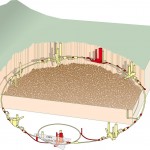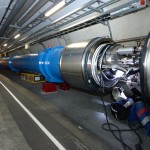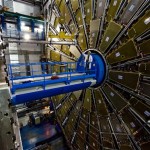And no, the world won’t end tomorrow
View images here
Read feature article on Australia and the Large Hadron Collider here
Read about The University of Melbourne and University of Sydney public/student events here
Just after 6pm today, Wednesday 10 September, the Large Hadron Collider will start up. Twenty years in the making, the A$6 billion machine will smash particles together in an attempt to recreate the conditions of the early universe fractions of a second after the Big Bang.
It’s the result of a collaboration between scientists from eighty five countries.
“Australian physicists have been involved from the beginning,” says Cathy Foley, President of the Australian Institute of Physics.
“A team lead by Geoff Taylor from the University of Melbourne and Kevin Varvell from the University of Sydney have contributed to ATLAS – one of six machines at the LHC that will attempt to detect the strange particles created,” she says. “They have designed detectors and shielding, developed software to model the behaviour of the detector, and software that triggers the collection of information. They’ve been supported by the Australian Government through the Australian Research Council.”
The collider is housed in a circular tunnel 27 kilometres long, at a depth of between 50 and 175 metres below the ground. As the particles smash together they will ‘break apart’ into smaller, more fundamental components, giving physicists a fleeting chance to observe those particles, some of which will never have been seen before.
“We know we are likely to find something very important, something scientifically quite profound,” says Geoff Taylor.
One of the most highly anticipated products of the collider might be the elusive Higgs boson, which could explain how other elementary particles acquire properties such as mass. If scientists can verifiy the existence of the Higgs boson, it would be a significant step in the search for a Grand Unified Theory, which aims to bring together three of the four known fundamental forces: electromagnetism, the strong nuclear force and the weak nuclear force, leaving out only gravity.
Everything about the LHC is large. The ATLAS detector is about half as big as Notre Dame Cathedral in Paris.
Australian companies were involved in constructing copper shields that form part of ATLAS, and in 2003 Professor Taylor’s team supervised the despatch of 14 pieces of shielding to LHC, weighing some 35 tonnes.
“The discoveries that will be made at the LHC will rewrite our understanding of how the universe began and the way it operates at the most fundamental level,” says Cathy.
She also dismisses the fears that the LHC will create a black hole that will somehow swallow up the earth. “Scientists think the kinds of collisions that the LHC will be generating happen all the time in nature,” she says.
Although the particles will be smashed together at speeds that generate large amounts of energy in sub-atomic terms, when you compare it to more everyday events they are less impressive, she notes.
“Each collision of a pair of protons in the LHC will release an amount of energy comparable to that of two colliding mosquitoes,” she says. “It’s like a rice-bubble pop.”
Click on image to view larger version


High resolution versions of these images and many more at http://cdsweb.cern.ch
Events celebrating the switch on of the Large Hadron Collider
The University of Melbourne
The University of Melbourne will host the only Australian satellite link for the ‘switch on’ of the Large Hadron Collider (LHC) at the Melbourne Museum. The event is part of a major world-wide broadcast organised by the laboratory CERN in Switzerland, involving live video hook-ups and world-feeds from participating institutions in 10 time zones worldwide. For more information about this event please contact, Rebecca Scott, Media Officer at the University of Melbourne rebeccas@unimelb.edu.au (03 8344 0181 or 0417 164 791).
University of Sydney – Build your own Big Bang: CERN’s Large Hadron Collider turns on.
At 5.30 pm AEST next Wednesday 10th September, scientists will hit the big green button on the world’s largest experiment, the Large Hadron Collider at CERN. The huge energies given to tiny particles in this experiment will take us closer to the Big Bang than we have ever been before and propel us towards answering questions of Life, The Universe and Everything. One of the thousands of scientists holding his breath is Dr Kevin Varvell from the School of Physics University of Sydney. “At last we can test some of our ideas about what we are made of!” he says. “Some ideas are very solid, some such as mini-black holes less so.”
At a public talk next Wednesday evening Dr Kevin and Dr Karl Kruszelnicki will be giving the low down on the Large Hadron Collider, colder than deep space, and buried 100 m in the ground in a tunnel 27 km long under the French-Swiss border – as well as streaming live video from CERN.
Venue: Footbridge Theatre, Camperdown campus, University of Sydney
Time: 7pm onwards
Date: Wednesday 10th September
RSVP: 9351 3472 or outreach@physics.usyd.edu.au by 5pm Tuesday 9th September


